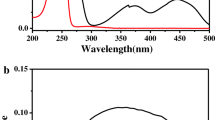Abstract
A photochromic system based on dracoflavylium, a natural pigment extracted from Dragon’s blood, a resin appearing in the injury parts of the tree Dracaena draco, is studied in water. The photochromism arises from the irradiation of the trans-chalcone, giving a mixture of flavylium cation/quinoidal base as a photoproduct via cis-chalcone and hemiketal. The performance of the photochromic system can be improved in the presence of (2-hydroxypropyl)-β-cyclodextrin. A mathematical model to account for the details of the kinetics and thermodynamics of the system was deduced. The model is general for all the host-guest systems involving the flavylium network of chemical reactions with 1: 1 stoichiometric association.
Similar content being viewed by others
References
F. Pina, M. J. Melo, C. T. Laia, J. Parola, J. C. Lima, Chemistry and Applications of Flavylium Compounds: A Handful of Colours, Chem. Soc. Rev., 2011, 41, 869–908.
F. Pina, M. J. Melo, M. Maestri, R. Ballardini, V. Balzani, Photochromism of 4′-Methoxyflavylium Perchlorate. A “Write-Lock-Read-Unlock-Erase” Molecular Switching System, J. Am. Chem. Soc., 1997, 119, 5556–5561.
M. Maafi, Useful Spectrokinetic Methods for the Investigation of Photochromic and Thermo-Photochromic Spiropyrans, Molecules, 2008, 13, 2260–2302.
N. Basílio, A. Fernandes, V. de Freitas, S. Gago, F. Pina, Effect of β-Cyclodextrin on the Chemistry of 3′,4′,7-Trihydroxyflavylium, New J. Chem., 2013, 37, 3166–3173.
F. Pina, L. Benedito, M. J. Melo, A. J. Parola, J. C. Lima, A. L. Maçanita, Structural Transformations of the Synthetic Salt 4′,7-Dihydroxyflavylim Chloride in Acid and Basic Aqueous Solutions. Part 1 - Ground-State, Anales de Quimica, Int. Ed., 1997, 93, 111–118.
M. J. Melo, M. Sousa, A. J. Parola, J. S. de Melo, F. Catarino, J. Marçalo, F. Pina, Identification of 7,4′-Dihydroxy-5-Methoxyflavylium in “Dragon’s Blood”: To Be or Not to Be an Anthocyanin., Chem. - Eur. J., 2007, 13, 1417–1422.
F. W. Küster and A. Thiel, Tabelle per le Analisi Chimiche e Chimico-Fisiche, Hoepli, Milano, 12nd edn, 1982, pp. 157–160.
M. Maestri, R. Ballardini, F. Pina, M. J. Melo, An Easy and Inexpensive Flash Spectroscopy Experiment, J. Chem. Educ., 1997, 74, 1314–1316.
A. M. Brown, A Step-by-Step Guide to Non-Linear Regression Analysis of Experimental Data Using a Microsoft Excel Spreadsheet, Comput. Methods Programs Biomed., 2001, 65, 191–200.
It can be easily shown that the apparent p Ka measured in the presence of a given concentration of HCD is given by; in the same way the apparent p K′a is given by.
V. Petrov, S. Stanimirov, I. K. Petrov, A. Fernandes, V. de Freitas, F. Pina, Emptying the β-Cyclodextrin Cavity by Light: Photochemical Removal of the trans-Chalcone of 4′,7-Dihydroxyflavylium, J. Phys. Chem., 2013, 117, 10692–10701.
F. Pina, Chemical Applications of Anthocyanins and Related Compounds. A Source of Bioinspiration, J. Agric. Food Chem U. 10.1021/jf404869m., in press.
T. C. S. Pace, C. Bohne, Dynamics of Guest Binding to Supramolecular Systems: Techniques and Selected Examples, Adv. Phys. Org. Chem., 2008, 42, 167–223.
R. Gomes, A. J. Parola, J. C. Lima, F. Pina, Solvent Effects on the Thermal and Photochemical Reactions of 4′-Iodo-8-Methoxyflavylium and Their Consequences on the Coloring Phenomena Caused by Anthocyanins in Plants, Chem. - Eur. J., 2006, 12, 7906–7912.
A. M. Sanchez, R. H. de Rossi, Effect of β-Cyclodextrin on the Thermal Cis - Trans Isomerization of Azobenzenes, J. Org. Chem., 1996, 61, 3446–3451.
The quantum yield was calculated based on the total light absorbed by the free and complexed trans-chalcone.
R. A. McClelland, G. H. McGall, Hydration of the Flavylium Ion. 2. The 4′-Hydroxyflavylium Ion, J. Org. Chem., 1982, 47, 3730–3736.
R. A. McClelland, S. Gedge, Hydration of the Flavylium Ion, J. Am. Chem. Soc., 1980, 102, 5838–5848.
Author information
Authors and Affiliations
Corresponding authors
Additional information
† Electronic supplementary information (ESI) available. See DOI: 10.1039/c4pp00190g
Rights and permissions
About this article
Cite this article
Lopes-Costa, T., Basílio, N., Pedrosa, J.M. et al. Photochromism of the natural dye 7,4′-dihydroxy-5-methoxyflavylium (dracoflavylium) in the presence of (2-hydroxypropyl)-β-cyclodextrin. Photochem Photobiol Sci 13, 1420–1426 (2014). https://doi.org/10.1039/c4pp00190g
Received:
Accepted:
Published:
Issue Date:
DOI: https://doi.org/10.1039/c4pp00190g




